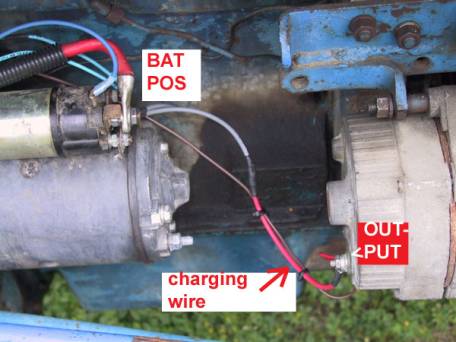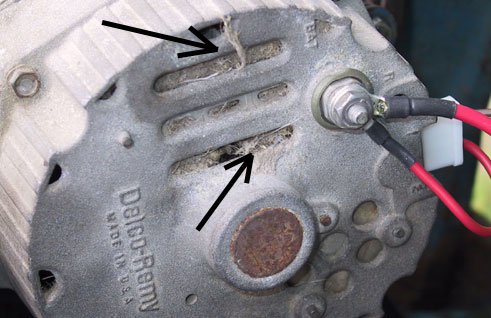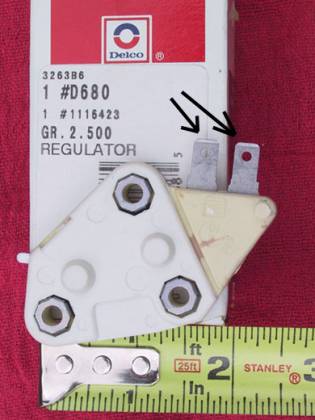|

|
The
Trend Setter
 |
Part
2
ONE-WIRE
compared to
THREE-WIRE
ALTERNATORS
In
recent years
it seems that the term ONE-WIRE has become a much-used
buzzword, and ONE-WIRE is often used by people who do not
understand it. Among
the GM SI series alternators, there is both the ONE-WIRE
type and the THREE-WIRE type. Many people who have called did not know that not
all alternators with a built-in voltage regulator are
“ONE-WIRE” types.
Many people simply refer to all alternators
with built-in voltage as ONE-WIRE.
(Lumping the THREE-WIRE and the ONE-WIRE, both with
built-in voltage regulator, into the same classification;
is incorrect and results from lack of being informed.)
With
this technical feature we will attempt to discuss,
compare, and provide the information needed to decide
which system is the best for particular applications. (ONE-WIRE, or THREE-WIRE, both with a built-in voltage
regulator.) And
we will discuss the advantages and disadvantages of each
type when used in different applications.

Shown
above is the first-generation GM Delco-Remy alternator
with built-in voltage regulator.
The “ONE-WIRE” alternator shown above only has
a heavy gauge wire connected from the output terminal to
the battery. The obvious advantage is that not much knowledge is needed to
wire it! (The
ONE-WIRE alternator shown above is the 10SI model.)
It’s
logical that Delco-Remy Division of GM would have
originally designed the “ONE-WIRE” version of their
10SI alternator. These
alternators have been widely used on agricultural and
industrial machinery.
Considering the number of companies building
tractors, forklifts, engines for irrigation pumps, air
compressors, and the many other examples of machinery
requiring an alternator, it would have been simple to
furnish the ONE-WIRE.
There’s not much to teach about wiring the
“ONE-WIRE.” And
so the “ONE-WIRE” alternator would have avoided a lot
of “how-to-wire-it” teaching sessions, which can occur
when supplying the THREE-WIRE system.
(Trust us, the tech calls can drive a person MAD!
And the need for knowledge of proper wiring is why
we made the part#ALT-1 kit, which comes with good
instructions and all the proper wiring parts.)
If
the “ONE-WIRE” would have worked well with the
complicated wiring involved for support of all the many
accessories on cars, then over the years GM could have
saved a fortune in wiring.
But GM did not compromise electrical system
performance in this area.
They did spend more money for engineering and
wiring to install the THREE-WIRE alternators, which will
deliver best performance. And as we shall see, there really is value to the little
extra work required to install the THREE-WIRE system.

The
“ONE-WIRE” alternator is best suited for
applications that need the alternator only for a battery
charger. Okay,
so it’s a little radical to use an old farm tractor as a
model in a site for High Performance cars. Ha!
But the tractor example makes a strong point about
the ONE-WIRE alternator system.
This
tractor is an application that only needs the alternator
for battery charging purpose.
This simple tractor has no lights, no
electrical accessories, and not even an ignition system
(The engine is a diesel model.)

And the
wire harness on tractors and most other
machinery is short in length, with fairly
heavy gauge size wire.
The ONE-WIRE alternator could satisfy the battery
charging needs on this simple old tractor.
It’s
important to notice the short-in-length charging wire on
the tractor. Significant
voltage drop will not occur with the battery charging wire
only a few inches in length.
And there are no accessories to hook-up downstream
from the alternator. The “remote voltage sensing”
option available with the THREE-WIRE is not needed with
this tractor application.

However…
Even the most simple of applications, like the
old tractor, can use the THREE-WIRE type alternator with
built-in voltage regulator (the two wire plug-in
plus the “charging wire).
Although it must be properly wired, the THREE-WIRE
type does work equally well for the tractor application.
The added benefit of wiring the tractor for the
THREE-WIRE alternator is that replacements will be less
expensive and more easily found.
(Since the “THREE-WIRE” type was used on many
years of all GM cars and trucks, it can be found at about
any place where auto parts are sold, and usually for far
less money than the special “ONE-WIRE” type.)
And a Warning Light on the dash in addition to a
gauge will be an option when the THREE-WIRE is installed.
TIPS
Notice the debris at the air-intake for cooling,
which probably resulted from operating in a dusty, dirty
environment. (see arrows) This needs attention, as
alternators require adequate cooling. What we should see through those air-intake openings is the
rectifier heat sink with aluminum cooling fins. Sometimes plugged air-intake is also a problem when
fiberglass hood insulators deteriorate on cars and trucks. That debris will have to be cleaned out of there.
The cooling fan at the front of these alternators
is an exhaust fan, and it pulls air in through the back of
the alternator where the rectifier heat sink is mounted. (That’s why the debris is stuck in the back-of the
alternator.)
Cooling
is very important to an alternator.
Machinery built by man is never 100% efficient.
But energy is never lost or destroyed (only
converted). Briefly
speaking, if an alternator design was only 50% efficient,
and 4 horsepower was required to operate the alternator;
then we would get 2 horsepower worth of electrical energy
from the alternator and 2 horsepower worth of heat energy
from the alternator.
And of course, as with engines, increasing the
output potential will increase the heat output. (Heat is
the by-product of efficiency loss.)
When
alternator output rating is increased, the cooling
capacity of the alternator should also be increased.
Beware of budget 100 amp alternators built
upon the 63 AMP rated, 10SI model case design, and
with only original design rectifiers and fans. The output potential is nearly doubled, and the cooling
capacity is reduced since the case will be filled with
more windings. And
be thankful for good companies like POWERMASTER, who
improve the cooling capacity when they increase output
potential. (POWERMASTER
also gives us the options of both “THREE-WIRE” and
“ONE-WIRE” alternators.)

The
difference between the ONE-WIRE and THREE-WIRE alternator
is the voltage regulator.
The Delco part # D680 voltage regulator shown above
is used in both the 10SI and 12SI THREE-WIRE models.
The same model of alternator can be assembled with
different types of voltage regulators (for ONE-WIRE or for
the THREE-WIRE system).
We do have options, and the choice is ours to make.
The
voltage regulator for the “ONE-WIRE” alternator is
often referred to as “SELF-EXCITING.”
The “self-exciting” terminology probably comes
from the old generator days, when testing the generator
output required “exciting” the field winding (which
involved powering-up the field winding so that it would
make a maximum strength “magnetic field”).
And the “self” part of the term comes from the
voltage regulator turn ON function without the assistance
of a dedicated wire circuit.
How the ONE-WIRE
Voltage Regulator Works
The
iron core material next to the field winding in the
alternator will retain some magnetism after once being
magnetized with field winding power-up (during assembly).
After the engine has been started, and the
alternator is spinning, the existing weak magnetic field
from the iron core material will cause the alternator to
produce a small amount of current. This small amount of current is used to turn the voltage
regulator electronics ON (rather than wiring a special
wiring circuit to turn the voltage regulator ON).
And of course the faster we spin the alternator,
the greater the potential for output.
That is why sometimes we have to rev the engine
once to kick in the “ONE-WIRE” alternator.
(We have to spin the field in the alternator fast
enough to make sufficient current to turn ON the
“self-exciting” voltage regulator.)
How the THREE-WIRE
Voltage Regulator Works
(the
Turn ON & Warning Light circuit)
With
the “THREE-WIRE” alternator model built for cars and
trucks, one of the voltage regulator terminals is wired to
an ignition switched OFF/ON source.
And the OFF/ON circuit may also be used to operate
a warning light at the dash.
(The THREE-WIRE type can be wired with or without a
warning light at the dash.
The warning light is an option–not a
requirement.)
REMOTE
VOLTAGE SENSING, a THREE-WIRE advantage
The other of the two
plug-in wires at the SI series alternator is the
“voltage-sensing” terminal for the voltage regulator.
Through the sensing-wire, the voltage regulator
monitors electrical system voltage and makes adjustments
to alternator output.
The regulator will adjust alternator output as
needed to maintain the place where the sensing-wire is
routed (at about 14.2 volts).
And the sensing-wire can be routed to a place
remote from the alternator (downstream).
This “remote
voltage-sensing” feature is often a big advantage when
running with a factory type wire harness from the Muscle
car period (60’s and early 70’s period cars and
trucks). Then
the alternator output will be adjusted according to what
goes on far downstream from the alternator–at the main
power distribution junction, which operates the whole car
plus charges the battery!


click
here to continue
to
the last part of this ONE-WIRE compared to THREE-WIRE
feature
|